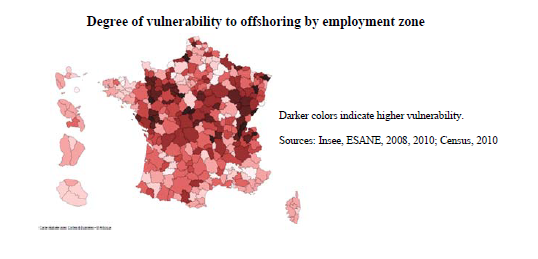Economie et Statistique / Economics and Statistics n° 497-498 Measuring and anticipating the vulnerability of territories to offshoring risks: An analysis on sectoral data in France
Article on one page
Key question
Recent empirical studies generally conclude that offshoring is of little impact at the macroeconomic level. However, it does cause significant asymmetric shocks in the territories. Some territories are more exposed to offshoring risks, for instance when specialised in activities that are vulnerable to globalisation. How can we better identify or even anticipate these shocks, based on the industrial specialisations of territories?
Methodology
Analysing the data at the NAF 700 level makes it possible to classify the manufacturing industry into four main types, depending on the skills-level required of jobs, their content of routine tasks and the product competitiveness. A sector offshoring index is then constructed based on the estimated relationship, by sector type, between changes in imports and that of jobs during the period 2008-2010, presuming offshoring when a sharp reduction in the workforce comes alongside an increase in imports. An original indicator illustrating each employment zone’s vulnerability to offshoring is calculated based on the weighted sector offshoring index for each sector in total employment in each zone.
Main results
Sectors that show low labour productivity and are intensive in routine work make up the “domestic sectors hardly offshorable”, 24% of manufacturing jobs, moderately capital-intensive and more focused on the domestic market, such as bulky construction and public works products (concrete), and “sectors with defensive offshoring”, 43% of manufacturing jobs, with low capital intensity, such as textiles and clothing.
Sectors calling to a significant extent on skilled labour and grey-matter functions are described as “exporting sectors hardly offshorable”, 14 % of manufacturing jobs, more capital-intensive and export-oriented, such as pharmaceutical products, and “offensive offshoring sectors”, 19% of manufacturing jobs, with low capital intensity, and largely exporting, such as luxury goods.
The vulnerability index underscores the localised or even scattered nature of offshoring shocks: the most exposed areas are found in the northern half of France, particularly in the east. There are few of them but their exposure to shocks shows high intensity. Among the most vulnerable are territories in the middle of less exposed areas and peripheral areas around the major cities, for example, around Paris, zones beyond the outer suburbs, particularly south of the Île-de-France region.

Main messages
A better understanding of the vulnerability of territories to the risks of offshoring should help direct public policies towards the relevant territories and audiences. The article recommends focusing State aid on the most vulnerable areas, in order to promote vocational training, research and innovation there, all of these being sources of regained comparative advantages and to encourage workers from these areas toward mobility. Lastly, the article recommends setting up an observatory to anticipate the risks of offshoring in the territories.
Article on one page (pdf, 51 Ko )



